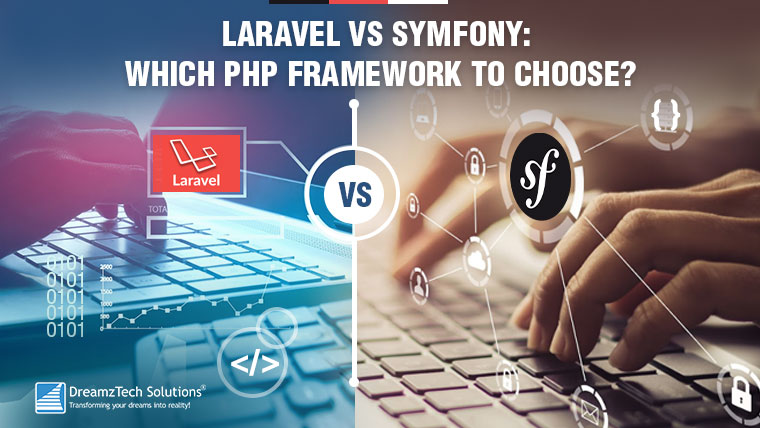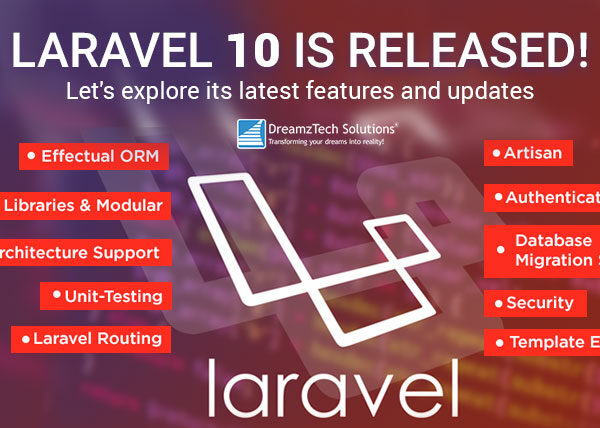Laravel and Symfony are two of the most popular PHP frameworks used for web application development. If you want to compare Laravel Vs Symfony, both frameworks provide developers with powerful tools and features that make it easier to create robust, secure, and scalable web applications.
Laravel is a relatively new PHP framework that was released in 2011. It was designed to be a more modern and elegant PHP framework that prioritizes developer productivity and simplicity. Laravel has a number of powerful features, such as a built-in ORM, powerful routing system, and an easy-to-use templating engine. It also has a vibrant community and a rich ecosystem of third-party packages, making it easy to find solutions to common problems.
Symfony, on the other hand, is a more established PHP framework that has been around since 2005. It is known for its modularity, stability, and extensibility, and is often used for large enterprise applications. Symfony has a wide range of components that can be used independently or together, and it provides developers with powerful tools for things like form handling, security, and testing.
Both Laravel and Symfony use the Model-View-Controller (MVC) architecture pattern, which helps to keep code organized and maintainable. They also both have robust support for database integration and provide developers with tools for handling things like data validation and form submission.
Overview:
Laravel: Know About Laravel, its strength & limitations
Laravel is a free, open-source PHP web application framework designed to help developers build high-quality, robust web applications quickly and easily. Laravel was developed by Taylor Otwell in 2011 and has since become one of the most popular PHP frameworks in the world, with a large and active community of developers.
Laravel is built on top of several powerful PHP components, including Symfony components, and follows the Model-View-Controller (MVC) architectural pattern, which separates the application into three interconnected components. Laravel also includes many built-in features and tools, such as a powerful query builder, easy-to-use authentication and authorization system, and an elegant templating engine called Blade.
One of the key strengths of Laravel is its simplicity and ease of use. Laravel’s syntax is clean and intuitive, making it easy to write and read code. Laravel also includes many useful tools and features, such as Artisan, a command-line interface for performing common tasks, and Eloquent, a simple and elegant ORM (Object-Relational Mapping) system for working with databases.
Overall, Laravel is a powerful and flexible PHP framework that makes it easy for developers to build high-quality web applications quickly and easily. It is an excellent choice for developers who want to focus on writing clean, elegant code without sacrificing functionality or performance.

Symfony: Know About Symfony, its strength & limitations
Symfony is a free, open-source PHP web application framework designed to help developers build complex, high-performance web applications quickly and easily. Symfony was first released in 2005 and has since become one of the most popular PHP frameworks in the world, with a large and active community of developers.
Symfony is built on top of several powerful PHP components, including the HttpFoundation component, which provides a set of reusable classes and interfaces for handling HTTP requests and responses, and the DependencyInjection component, which allows developers to easily manage dependencies between components.
One of the key strengths of Symfony is its flexibility and modularity. Symfony is designed to be highly configurable and customizable, allowing developers to choose only the components they need for their specific application. Symfony also includes many built-in tools and features, such as a powerful command-line interface called Console, a robust routing system, and a comprehensive testing framework.
Another strength of Symfony is its focus on best practices and standards. Symfony follows the Model-View-Controller (MVC) architectural pattern and adheres to the PSR-2 coding standard, making it easy for developers to write clean, well-structured code.
However, one of the potential limitations of Symfony is its steep learning curve. Symfony is a more advanced PHP framework that requires a solid understanding of object-oriented programming, design patterns, and software architecture. It may not be the best choice for smaller or less complex projects that require a more lightweight framework.
Overall, Symfony is a powerful and flexible PHP framework that is well-suited for building complex, high-performance web applications. It is an excellent choice for developers who want to follow best practices and standards and have the skills and experience necessary to work with a more advanced PHP framework.
Market Share Comparison between Laravel & Symfony:
Laravel and Symfony are both popular PHP frameworks used for web application development. While there is no definitive market share data available, there are some indicators that can help us make a comparison.
One such indicator is the popularity of these frameworks on GitHub, a widely used code repository. According to GitHub’s “Trending” section, Laravel is currently more popular than Symfony, with more stars, forks, and contributors. However, this is just one data point and does not necessarily reflect the wider market share.
Another indicator is the number of job listings that mention each framework. According to job search websites like Indeed and Glassdoor, both Laravel and Symfony are in high demand, but Laravel has slightly more job listings than Symfony.
It’s worth noting that Laravel is a newer framework than Symfony, having been released in 2011 compared to Symfony’s release in 2005. Laravel’s popularity may be attributed to its more modern approach, easier-to-use syntax, and extensive documentation. Symfony, on the other hand, has a reputation for being more stable and mature, making it a popular choice for large enterprise applications.
Overall, while Laravel seems to be more popular than Symfony in terms of GitHub activity and job listings, it’s important to keep in mind that both frameworks have their own strengths and weaknesses, and the choice between them depends on the specific needs of the project.
Industry Stats:
Google Trends says that Laravel has been the most popular PHP framework for the last 5 years. Symfony is 2nd on the list. It’s obvious if you are looking for laravel developer or want to hire laravel developer, you will get more number of developers to choose.

Laravel Vs Symfony: Which one to choose in 2023?
Choosing between Laravel and Symfony in 2023 depends on several factors, such as project requirements, development team skills, budget, and timeline. Here is an ultimate guide to help you decide:
- Project Requirements: The first step is to identify the project’s requirements, such as the size, complexity, and functionality. Symfony is better suited for large, complex projects that require a high level of customization, while Laravel is ideal for smaller to medium-sized projects that require faster development and a focus on ease of use.
- Developer Skills: Another factor to consider is the skills of the development team. Symfony has a steeper learning curve and requires more advanced programming skills, such as knowledge of object-oriented programming, dependency injection, and event-driven architecture. Laravel, on the other hand, has a lower barrier to entry and is more beginner-friendly.
- Budget and Timeline: Budget and timeline are also important factors to consider when choosing between Laravel and Symfony. Symfony requires more development time and expertise, which can increase the cost of the project. Laravel, on the other hand, is faster to develop and has a shorter learning curve, which can help reduce the cost and time to market.
- Community and Ecosystem: Both Laravel and Symfony have large and active communities of developers, which offer a wide range of third-party packages, plugins, and tools. Symfony has a more extensive ecosystem with more advanced features and libraries, while Laravel has a more user-friendly ecosystem focused on developer productivity.
- Future Proofing: Finally, it’s essential to consider the future of the project and the long-term maintenance and scalability requirements. Symfony’s advanced features and flexibility make it a good choice for projects that require a high level of customization and scalability. Laravel’s user-friendly features and ease of use make it ideal for projects that require fast development and shorter time-to-market.
In conclusion, choosing between Laravel and Symfony in 2023 depends on several factors, such as project requirements, development team skills, budget, timeline, and future-proofing. Both frameworks have their strengths and limitations, and the choice largely depends on the specific needs of the project and the skills and preferences of the development team.
DreamzTech Solutions is a leading Laravel Development Company in USA with development offices in USA, UK & India. Hire Laravel Developer from our 250+ Development Team and Create your web application result-oriented, scalable, robust, secure.



